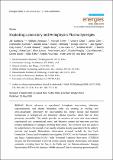Exploiting Laboratory and Heliophysics Plasma Synergies
Author(s)
Dahlburg, Jill; Amatucci, William; Brown, Michael; Chan, Vincent; Chen, James; Cothran, Christopher; Chua, Damien; Dahlburg, Russell; Doschek, George; Egedal-Pedersen, Jan; Forest, Cary; Howard, Russell; Huba, Joseph; Ko, Yuan-Kuen; Krall, Jonathan; Laming, J. Martin; Lin, Robert P.; Linton, Mark; Lukin, Vyacheslav; Murphy, Ronald; Rakowski, Cara; Socker, Dennis; Tylka, Allan; Vourlidas, Angelos; Warren, Harry; Wood, Brian; ... Show more Show less
DownloadDahlburg-2010-Exploiting Laboratory and Heliophysics Plasma Synergies.pdf (2.857Mb)
PUBLISHER_CC
Publisher with Creative Commons License
Creative Commons Attribution
Terms of use
Metadata
Show full item recordAbstract
Recent advances in space-based heliospheric observations, laboratory experimentation, and plasma simulation codes are creating an exciting new cross-disciplinary opportunity for understanding fast energy release and transport mechanisms in heliophysics and laboratory plasma dynamics, which had not been previously accessible. This article provides an overview of some new observational, experimental, and computational assets, and discusses current and near-term activities towards exploitation of synergies involving those assets. This overview does not claim to be comprehensive, but instead covers mainly activities closely associated with the authors’ interests and reearch. Heliospheric observations reviewed include the Sun Earth Connection Coronal and Heliospheric Investigation (SECCHI) on the National Aeronautics and Space Administration (NASA) Solar Terrestrial Relations Observatory (STEREO) mission, the first instrument to provide remote sensing imagery observations with spatial continuity extending from the Sun to the Earth, and the Extreme-ultraviolet Imaging Spectrometer (EIS) on the Japanese Hinode spacecraft that is measuring spectroscopically physical parameters of the solar atmosphere towards obtaining plasma temperatures, densities, and mass motions. The Solar Dynamics Observatory (SDO) and the upcoming Solar Orbiter with the Heliospheric Imager (SoloHI) on-board will also be discussed. Laboratory plasma experiments surveyed include the line-tied magnetic reconnection experiments at University of Wisconsin (relevant to coronal heating magnetic flux tube observations and simulations), and a dynamo facility under construction there; the Space Plasma Simulation Chamber at the Naval Research Laboratory that currently produces plasmas scalable to ionospheric and magnetospheric conditions and in the future also will be suited to study the physics of the solar corona; the Versatile Toroidal Facility at the Massachusetts Institute of Technology that provides direct experimental observation of reconnection dynamics; and the Swarthmore Spheromak Experiment, which provides well-diagnosed data on three-dimensional (3D) null-point magnetic reconnection that is also applicable to solar active regions embedded in pre-existing coronal fields. New computer capabilities highlighted include: HYPERION, a fully compressible 3D magnetohydrodynamics (MHD) code with radiation transport and thermal conduction; ORBIT-RF, a 4D Monte-Carlo code for the study of wave interactions with fast ions embedded in background MHD plasmas; the 3D implicit multi-fluid MHD spectral element code, HiFi; and, the 3D Hall MHD code VooDoo. Research synergies for these new tools are primarily in the areas of magnetic reconnection, plasma charged particle acceleration, plasma wave propagation and turbulence in a diverging magnetic field, plasma atomic processes, and magnetic dynamo behavior.
Date issued
2010-05Department
Massachusetts Institute of Technology. Department of PhysicsJournal
Energies
Publisher
Molecular Diversity Preservation International
Citation
Dahlburg, Jill et al. “Exploiting Laboratory and Heliophysics Plasma Synergies.” Energies 3.5 (2010) : 1014-1048. ©2010 MDPI Publishing.
Version: Final published version
ISSN
1996-1073